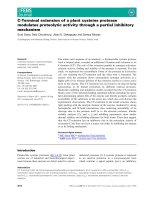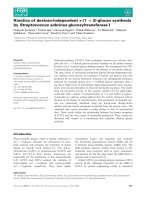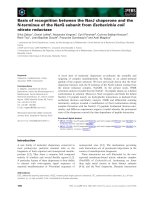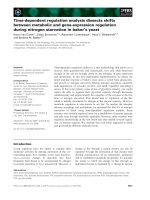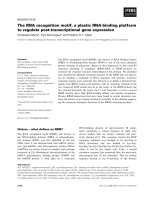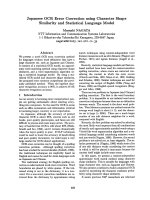Báo cáo khoa học: "Japanese Idiom Recognition: Drawing a Line between Literal and Idiomatic Meanings" docx
Bạn đang xem bản rút gọn của tài liệu. Xem và tải ngay bản đầy đủ của tài liệu tại đây (114.15 KB, 8 trang )
Proceedings of the COLING/ACL 2006 Main Conference Poster Sessions, pages 353–360,
Sydney, July 2006.
c
2006 Association for Computational Linguistics
Japanese Idiom Recognition:
Drawing a Line between Literal and Idiomatic Meanings
Chikara Hashimoto
∗
Satoshi Sato
†
Takehito Utsuro
‡
∗
Graduate School of
Informatics
Kyoto University
Kyoto, 606-8501, Japan
†
Graduate School of
Engineering
Nagoya University
Nagoya, 464-8603, Japan
‡
Graduate School of Systems
and Information Engineering
University of Tsukuba
Tsukuba, 305-8573, Japan
Abstract
Recognizing idioms in a sentence is im-
portant to sentence understanding. This
paper discusses the lexical knowledge of
idioms for idiom recognition. The chal-
lenges are that idioms can be ambiguous
between literal and idiomatic meanings,
and that they can be “transformed” when
expressed in a sentence. However, there
has been little research on Japanese idiom
recognition with its ambiguity and trans-
formations taken into account. We pro-
pose a set of lexical knowledge for idiom
recognition. We evaluated the knowledge
by measuring the performance of an idiom
recognizer that exploits the knowledge. As
a result, more than 90% of the idioms in a
corpus are recognized with 90% accuracy.
1 Introduction
Recognizing idioms in a sentence is important to
sentence understanding. Failure of recognizing id-
ioms leads to, for example, mistranslation.
In the case of the translation service of Excite
1
,
it sometimes mistranslates sentences that contain
idioms such as (1a), due to the recognition failure.
(1) a. Kare-wa
he-
TOP
mondai-no
problem-
GEN
kaiketu-ni
solving-
DAT
hone-o
bone-
ACC
o-tta.
break-
PAST
“He made an effort to solve the problem.”
b. “He broke his bone to the resolution of a
question.”
1
/>(1a) contains an idiom, hone-o oru (bone-ACC
break) “make an effort.” (1b) is the mistranslation
of (1a), in which the idiom is interpreted literally.
In this paper, we discuss lexical knowledge for
idiom recognition. The lexical knowledge is im-
plemented in an idiom dictionary that is used by
an idiom recognizer we implemented. Note that
the idiom recognition we define includes distin-
guishing literal and idiomatic meanings.
2
Though
there has been a growing interest in MWEs (Sag
et al., 2002), few proposals on idiom recognition
take into account ambiguity and transformations.
Note also that we tentatively define an idiom as a
phrase that is semantically non-compositional. A
precise characterization of the notion “idiom” is
beyond the scope of the paper.
3
Section 2 defines what makes idiom recognition
difficult. Section 3 discusses the classification of
Japanese idioms, the requisite lexical knowledge,
and implementation of an idiom recognizer. Sec-
tion 4 evaluates the recognizer that exploits the
knowledge. After the overview of related works
in Section 5, we conclude the paper in Section 6.
2 Two Challenges of Idiom Recognition
Two factors make idiom recognition difficult: am-
biguity between literal and idiomatic meanings
and “transformations” that idioms could un-
dergo.
4
In fact, the mistranslation in (1) is caused
by the inability of disambiguation between the two
meanings. “Transformation” also causes mistrans-
2
Some idioms represent two or three idiomatic meanings.
But those meanings in an idiom are not distinguished. We
concerned only whether a phrase is used as an idiom or not.
3
For a detailed discussion of what constitutes the notion
of (Japanese) idiom, see Miyaji (1982), which details usages
of commonly used Japanese idioms.
4
The term “transformation” in the paper is not relevant to
the Chomskyan term in Generative Grammar.
353
lation. Sentences in (2) and (3a) contain an idiom,
yaku-ni tatu (part-
DAT stand) “serve the purpose.”
(2) Kare-wa
he-
TOP
yaku-ni
part-
DAT
tatu.
stand
“He serves the purpose.”
(3) a. Kare-wa
he-
TOP
yaku-ni
part-
DAT
sugoku
very
tatu.
stand
“He really serves the purpose.”
b. “He stands enormously in part.”
Google’s translation system
5
mistranslates (3a) as
in (3b), which does not make sense,
6
though it suc-
cessfully translates (2). The only difference be-
tween (2) and (3a) is that bunsetu
7
constituents of
the idiom are detached from each other.
3 Knowledge for Idiom Recognition
3.1 Classification of Japanese Idioms
Requisite lexical knowledge to recognize an idiom
depends on how difficult it is to recognize it. Thus,
we first classify idioms based on recognition diffi-
culty. The recognition difficulty is determined by
the two factors: ambiguity and transformability.
Consequently, we identify three classes (Figure
1).
8
Class A is not transformable nor ambigu-
ous. Class B is transformable but not ambiguous.
9
Class C is transformable and ambiguous. Class A
amounts to unambiguous single words, which are
easy to recognize, while Class C is the most diffi-
cult to recognize. Only Class C needs further clas-
sifications, since only Class C needs disambigua-
tion and lexical knowledge for disambiguation de-
pends on its part-of-speech (POS) and internal
structure. The POS of Class C is either verbal
or adjectival, as in Figure 1. Internal structure
represents constituent words’ POS and a depen-
dency between bunsetus. The internal structure
5
tools
6
In fact, the idiom has no literal interpretation.
7
A bunsetu is a syntactic unit in Japanese, consisting of
one independent word and more than zero ancillary words.
The sentence in (3a) consists of four bunsetu constituents.
8
The blank space at theupper left in the figure implies that
there is no idiom that does not undergo any transformation
and yet is ambiguous. Actually, we have not come up with
such an example that should fill in the blank space.
9
Anonymous reviewers pointed out that Class A and B
could also be ambiguous. In fact, one can devise a context
that makes the literal interpretation of those Classes possible.
However, virtually no phrase of Class A or B is interpreted
literally in real texts, and we think our generalization safely
captures the reality of idioms.
AmbiguousUnambiguous
TransformableUntransformable
Class B
yaku-ni
part-
DAT
tatu
stand
“serve the purpose”
- Verbal
- Adjectival
Class C
hone-o
bone-
ACC
oru
break
“make an effort”
- Verbal
- Adjectival
Class A
mizu-mo
water-
TOO
sitataru
drip
“extremely handsome”
- Adnominal
- Nominal
- Adverbial
More Difficult
Figure 1: Idiom Classification based on the
Recognition Difficulty
of hone-o oru (bone-
ACC bone), for instance, is
“(Noun/Particle Verb),” abbreviated as “(N/P V).”
Then, let us give a full account of the further
classification of Class C. We exploit grammatical
differences between literal and idiomatic usages
for disambiguation. We will call the knowledge of
the differences the disambiguation knowledge.
For instance, a phrase, hone-o oru, does not al-
low passivization when used as an idiom, though
it does when used literally. Thus, (4), in which the
phrase is passivized, cannot be an idiom.
(4) hone-ga
bone-
NOM
o-rareru
break-
PASS
“A bone is broken.”
In this case, passivizability can be used as a dis-
ambiguation knowledge. Also, detachability of
the two bunsetu constituents can serve for disam-
biguating the idiom; they cannot be separated. In
general, usages applicable to idioms are also ap-
plicable to literal phrases, but the reverse is not
always true (Figure 2). Then, finding the disam-
Usages Applicable to Only Literal Phrases
Usages Applicable to Both
Idioms and Literal Phrases
Figure 2: Difference of Applicable Usages
biguation knowledge amounts to finding usages
applicable to only literal phrases.
Naturally, the disambiguation knowledge for an
idiom depends on its POS and internal structure.
354
As for POS, disambiguation of verbal idioms can
be performed by the knowledge of passivizability,
while that of adjectival idioms cannot. Regarding
internal structure, detachability should be anno-
tated on every boundary of bunsetus. Thus, the
number of annotations of detachability depends on
the number of bunsetus of an idiom.
There is no need for further classification of
Class A and B, since lexical knowledge for them is
invariable. The next section mentions their invari-
ableness. After all, Japanese idioms are classified
as in Figure 3. The whole picture of the subclasses
of Class C remains to be seen.
3.2 Knowledge for Each Class
What lexical knowledge is needed for each class?
Class A needs only a string information; idioms
of the class amount to unambiguous single words.
A string information is undoubtedly invariable
across all kinds of POS and internal structure.
Class B requires not only a string but also
knowledge that normalizes transformations id-
ioms could undergo, such as passivization and de-
tachment of bunsetus. We identify three types of
transformations that are relevant to idioms: 1) De-
tachment of Bunsetu Constituents, 2) Predicate’s
Change, and 3) Particle’s Change. Predicate’s
change includes inflection, attachment of a neg-
ative morpheme, a passive morpheme or modal
verbs, and so on. Particle’s change represents at-
tachment of topic or restrictive particles. (5b) is an
example of predicate’s change from (5a) by adding
a negative morpheme to a verb. (5c) is an example
of particle’s change from (5a) by adding a topic
particle to the preexsistent particle of an idiom.
(5) a. Kare-wa
he-
TOP
yaku-ni
part-
DAT
tatu.
stand
“He serves the purpose.”
b. Kare-wa
he-
TOP
yaku-ni
part-
DAT
tat-anai.
stand-NEG
“He does not serve the purpose.”
c. Kare-wa
he-
TOP
yaku-ni-wa
part-
DAT-TOP
tatu.
stand
“He serves the purpose.”
To normalize the transformations, we utilize a
dependency relation between constituent words,
and we call it the dependency knowledge. This
amounts to checking the presence of all the con-
stituent words of an idiom. Note that we ignore,
among constituent words, endings of a predicate
and case particles, ga (
NOM) and o (ACC), since
they could change their forms or disappear.
The dependency knowledge is also invariable
across all kinds of POS and internal structure.
Class C requires the disambiguation knowl-
edge, as well as all the knowledge for Class B.
As a result, all the requisite knowledge for id-
iom recognition is summarized as in Table 1.
String Dependency Disambiguation
Class A ✔
Class B ✔ ✔
Class C ✔ ✔ ✔
Table 1: Requisite Knowledge for each Class
As discussed in §3.1, the disambiguation
knowledge for an idiom depends on which sub-
class it belongs to. A comprehensive idiom recog-
nizer calls for all the disambiguation knowledge
for all the subclasses, but we have not figured out
all of them. Then, we decided to blaze a trail to
discover the disambiguation knowledge by inves-
tigating the most commonly used idioms.
3.3 Disambiguation Knowledge for the
Verbal (N/P V) Idioms
What type of idiom is used most commonly? The
answer is the verbal (N/P V) type like hone-
o oru (bone-
ACC break); it is the most abundant in
terms of both type and token. Actually, 1,834 out
of 4,581 idioms (40%) in Kindaichi and Ikeda
(1989), which is a Japanese dictionary with more
than 100,000 words, are this type.
10
Also, 167,268
out of 220,684 idiom tokens in Mainichi newspa-
per of 10 years (’91–’00) (76%) are this type.
11
Then we discuss what can be used to disam-
biguate the verbal (N/P V) type. First, we exam-
ined literature of linguistics (Miyaji, 1982; Morita,
1985; Ishida, 2000) that observed characteristics
of Japanese idioms. Then, among the characteris-
tics, we picked those that could help with the dis-
ambiguation of the type. (6) summarizes them.
10
Counting was performed automatically by means of the
morphological analyzer ChaSen (Matsumoto et al., 2000)
with no human intervention. Note that Kindaichi and Ikeda
(1989) consists of 4,802 idioms, but 221 of them were ig-
nored since they contained unknown words for ChaSen.
11
We counted idiom tokens by string matching with inflec-
tion taken into account. And we referred to Kindaichi and
Ikeda (1989) for a comprehensive idiom list. Note that count-
ing was performed totally automatically.
355
Recognition
Difficulty
POS
Internal
Structure
Japanese Idioms
Class C
Verb
(N/P V)
hone-o
bone-
ACC
oru
break
‘make an effort’
(N/P N/P V)
mune-ni
chest-
DAT
te-o
hand-
ACC
ateru
put
‘think over’
···
Adj
(N/P A)
atama-ga
head-
NOM
itai
ache
‘be in trouble’
···
Class B
yaku-ni
part-
DAT
tatu
stand
‘serve the purpose’
Class A
mizu-mo
water-TOO
sitataru
drip
‘extremely handsome’
Figure 3: Classification of Japanese Idioms for the Recognition Task
(6) Disambiguation Knowledge for the
Verbal (N/P V) Idioms
a. Adnominal Modification Constraints
I. Relative Clause Prohibition
II. Genitive Phrase Prohibition
III. Adnominal Word Prohibition
b. Topic/Restrictive Particle Constraints
c. Voice Constraints
I. Passivization Prohibition
II. Causativization Prohibition
d. Modality Constraints
I. Negation Prohibition
II. Volitional Modality Prohibition
12
e. Detachment Constraint
f. Selectional Restriction
For example, the idiom, hone-o oru, does not al-
low adnominal modification by a genitive phrase.
Thus, (7) can be interpreted only literally.
(7) kare-no
he-GEN
hone-o
bone-
ACC
oru
break
“(Someone) breaks his bone.”
That is, the Genitive Phrase Prohibition, (6aII), is
in effect for the idiom. Likewise, the idiom does
not allow its case particle o (
ACC) to be substi-
tuted with restrictive particles such as dake (only).
Thus, (8) represents only a literal meaning.
(8) hone-dake
bone-ONLY
oru
break
“(Someone) breaks only some bones.”
12
“Volitional Modality” represents those verbal expres-
sions of order, request, permission, prohibition, and volition.
This means the Restrictive Particle Constraint,
(6b), is also in effect. Also, (4) shows that the
Passivization Prohibition, (6cI), is in effect, too.
Note that the constraints in (6) are not always
in effect for an idiom. For instance, the Causativi-
zation Prohibition, (6cII), is invalid for the idiom,
hone-o oru. In fact, (9a) can be interpreted both
literally and idiomatically.
(9) a. kare-ni
he-
DAT
hone-o
bone-
ACC
or-aseru
break-CAUS
b. “(Someone) makes him break a bone.”
c. “(Someone) makes him make an effort.”
3.4 Implementation
We implemented an idiom dictionary based on the
outcome above and a recognizer that exploits the
dictionary. This section illustrates how they work,
and we focus on Class B and C hereafter.
The idiom recognizer looks up dependency
patterns in the dictionary that match a part of the
dependency structure of a sentence (Figure 4). A
dependency pattern is equipped with all the req-
uisite knowledge for idiom recognition. Rough
sketch of the recognition algorithm is as follows:
1. Analyze the morphology and dependency
structures of an input sentence.
2. Look up dependency patterns in the dictio-
nary that match a part of the dependency
structure of the input sentence.
3. Mark constituents of an idiom in the sentence
if any.
13
Constituents that are marked are
constituent words and bunsetu constituents
that include one of those constituent words.
13
As a constituent marker, we use an ID that is assigned to
each idiom in the dictionary.
356
Input
yaku-ni-wa
part-
DAT-TOP
mattaku
totally
tat-anai
stand-
NEG
Morphology &
Dependency
Analysis
Dependency
Matching
yaku
part
/ni
DAT
/wa
TOP
mattaku
totally
tatu
stand
/ nai
NEG
Output
yaku
part
/ ni
DAT
/wa
TOP
mattaku
totally
tatu
stand
/ nai
NEG
Idiom
Recognizer
Idiom
Dictionary
···
yaku
part
/ni
DAT
tatu
stand
···
Dependency Pattern
Figure 4: Internal Working of the Idiom Recognizer
Input Output
Idiom
Recognizer
ChaSen
Morphology
Analysis
CaboCha
Dependency
Analysis
TGrep2
Dependency
Matching
Dependency Pattern
Generator
Pattern DB
Idiom
Dictionary
Figure 5: Organization of the System
As in Figure 5, we use ChaSen as a morphol-
ogy analyzer and CaboCha (Kudo and Matsumoto,
2002) as a dependency analyzer. Dependency
matching is performed by TGrep2 (Rohde, 2005),
which finds syntactic patterns in a sentence or tree-
bank. The dependency pattern is usually getting
complicated since it is tailored to the specifica-
tion of TGrep2. Thus, we developed the Depen-
dency Pattern Generator that compiles the pattern
database from a human-readable idiom dictionary.
Only the difference in treatments of Class B and
C lies in their dependency patterns. The depen-
dency pattern of Class B consists of only its depen-
dency knowledge, while that of Class C consists
of not only its dependency knowledge but also its
disambiguation knowledge (Figure 6).
The idiom dictionary consists of 100 idioms,
which are all verbal (N/P V) and belong to either
Class B or C. Among the knowledge in (6), the
Selectional Restriction has not been implemented
yet. The 100 idioms are those that are used most
frequently. To be precise, 50 idioms in Kindaichi
and Ikeda (1989) and 50 in Miyaji (1982) were
extracted by the following steps:
14
1. From Miyaji (1982), 50 idioms that were
14
We counted idiom tokens by string matching with inflec-
tion taken into account. Note that counting was performed
automatically without human intervention.
used most frequently in Mainichi newspaper
of 10 years (’91–’00) were extracted.
2. From Kindaichi and Ikeda (1989), 50 idioms
that were used most frequently in the newspa-
per of 10 years but were not included in the
50 idioms from Miyaji (1982) were extracted.
As a result, 66 out of the 100 idioms were Class
B, and the other 34 idioms were Class C.
15
4 Evaluation
4.1 Experiment Condition
We conducted an experiment to see the effective-
ness of the lexical knowledge we proposed.
As an evaluation corpus, we collected 300 ex-
ample sentences of the 100 idioms from Mainichi
newspaper of ’95: three sentences for each id-
iom. Then we added another nine sentences for
three idioms that are orthographic variants of one
of the 100 idioms. Among the three idioms, one
belonged to Class B and the other two belonged to
Class C. Thus, 67 out of the 103 idioms were Class
B and the other 36 were Class C. After all, 309
15
We found that the most frequently used 100 idioms in
Kindaichi and Ikeda (1989) cover as many as 53.49% of all
tokens in Mainichi newspaper of 10 years. This implies that
our dictionary accounts for approximately half of all idiom
tokens in a corpus.
357
Dependency Pattern
Disambiguation
Knowledge
−Adnominal
Modification Cs
−Topic/Restrictive
Particle Cs
−Detachment C
−Voice Cs
−Modality Cs
Dependency
Knowledge
− Dependency of Constituents
hone
bone
/o
ACC
oru
break
hone
bone
/o
ACC
oru
break
Figure 6: Dependency Pattern of Class C
sentences were prepared. Table 2 shows the break-
down of them. “Positive” indicates sentences in-
Class B Class C Total
Positive 200 66 266
Negative
14243
Total 201 108 309
Table 2: Breakdown of the Evaluation Corpus
cluding a true idiom, while “Negative” indicates
those including a literal-usage “idiom.”
A baseline system was prepared to see the ef-
fect of the disambiguation knowledge. The base-
line system was the same as the recognizer except
that it exploited no disambiguation knowledge.
4.2 Result
The result is shown in Table 3. The left side shows
the performances of the recognizer, while the right
side shows that of the baseline. Differences of per-
formances between the two systems are marked
with bold. Recall, Precision, and F-Measure, are
calculated using the following equations.
Recall =
|C orrect Outputs|
|Positive|
P recision =
|C orrect Outputs|
|All Outputs|
F -Measure =
2 × P recision × Recall
P recision + Recall
As a result, more than 90% of the idioms can be
recognized with 90% accuracy. Note that the rec-
ognizer made fewer errors due to the employment
of the disambiguation knowledge.
The result shows the high performances. How-
ever, there turns out to be a long way to go to solve
the most difficult problem of idiom recognition:
drawing a line between literal and idiomatic mean-
ings. In fact, the precision of recognizing idioms
of Class C remains less than 70% as in Table 3.
Besides, the recognizer successfully rejected only
15 out of 42 negative sentences. That is, its suc-
cess rate of rejecting negative ones is only 35.71%
4.3 Discussion of the Disambiguation
Knowledge
First of all, positive sentences, i.e., sentences con-
taining true idioms, are in the blank region of Fig-
ure 2, while negative ones, i.e., those containing
literal phrases, are in both regions. Accordingly,
the disambiguation amounts to i) rejecting nega-
tive ones in the shaded region, ii) rejecting nega-
tive ones in the blank region, or iii) accepting pos-
itive ones in the blank region. i) is relatively easy
since there are visible evidences in a sentence that
tell us that it is NOT an idiom. However, ii) and
iii) are difficult due to the absence of visible evi-
dences. Our method is intended to perform i), and
thus has an obvious limitation.
Next, we look cloosely at cases of success or
failure of rejecting negative sentences. There were
15 cases where rejection succeeded, which corre-
spond to i). The disambiguation knowledge that
contributed to rejection and the number of sen-
tences it rejects are as follows.
16
1. Genitive Phrase Prohibition (6aII) 6
2. Relative Clause Prohibition (6aI) 5
3. Detachment Constraint (6e) 2
4. Negation Prohibition (6dI) 1
This shows that the Adnominal Modification Con-
straints, 1. and 2. above, are the most effective.
There were 27 cases where rejection failed.
These are classified into two types:
16
There was one case where rejection succeeded due to the
dependency analysis error.
358
Class B Class C All
Recall 0.975 (
195
200
) 0.939 (
62
66
) 0.966 (
257
266
)
Precision
1.000 (
195
195
) 0.697 (
62
89
) 0.905 (
257
284
)
F-Measure
0.987 0.800 0.935
Class B Class C All
0.975 (
195
200
) 0.939 (
62
66
) 0.966 (
257
266
)
1.000 (
195
195
) 0.602 (
62
103
) 0.862 (
257
298
)
0.987
0.734 0.911
Table 3: Performances of the Recognizer (left side) and the Baseline System (right side)
1. Those that could have been rejected by the
Selectional Restriction (6f) 5
2. Those that might be beyond the current tech-
nology 22
1. and 2. correspond to i) and ii), respectively.
We see that the Selectional Restriction would have
been as effective as the Adnominal Modification
Constraints. A part of a sentence that the knowl-
edge could have rejected is below.
(10) basu-ga
bus-
NOM
tyuu-ni
midair-
DAT
ui-ta
float-
PAST
“The bus floated in midair.”
An idiom, tyuu-ni uku (midair-
DAT float) “remain
to be decided,” takes as its argument something
that can be decided, i.e.,
1000:abstract rather
than
2:concrete in the sense of the Goi-Taikei
ontology (Ikehara et al., 1997). Thus, (10) has no
idiomatic sense.
A simplified example of 2. is illustrated in (11).
(11) ase-o
sweat-
ACC
nagasi-te
shed-and
huku-o
clothes-
ACC
kiru-yorimo,
wear-rather.than,
hadaka-ga
nudity-
NOM
gouriteki-da
rational-
DECL
“It makes more sense to be naked than
wearing clothes in a sweat.”
The phrase ase-o nagasu (sweat-
ACC shed) could
have been an idiom meaning “work hard.” It is
contextual knowledge that prevented it from being
the idiom. Clearly, our technique is unable to han-
dle such a case, which belongs to ii), since no vis-
ible evidence is available. Dealing with that might
require some sort of machine learning technique
that exploits contextual information. Exploring
that possibility is one of our future works.
Finally, the 42 negative sentences consist of 15
sentences, which we could disambiguate, 5 sen-
tences, which Selectional Restriction could have
disambiguated, and 22, which belong to ii) and are
beyond the current technique. Thus, the real chal-
lenge lies in 7% (
22
309
) of all idiom occurrences.
4.4 Discussion of the Dependency Knowledge
The dependency knowledge failed in only five
cases. Three of them were due to the defect
of dealing with case particles’ change like omis-
sion. The other two cases were due to the noun
constituent’s incorporation into a compound noun.
(12) is a part of such a case.
(12) kaihuku-kidou-ni
recovery-orbit-
DAT
nori-hajimeru
ride-begin
“(Economics) get back on a recovery track.”
The idiom, kidou-ni noru (orbit-
DAT ride) “get on
track,” has a constituent, kidou, which is incorpo-
rated into a compound noun kaihuku-kidou “re-
covery track.” This is unexpected and cannot be
handled by the current machinery.
5 Related Work
There has been a growing awareness of Japanese
MWE problems (Baldwin and Bond, 2002). How-
ever, few attempts have been made to recognize id-
ioms in a sentence with their ambiguity and trans-
formations taken into account. In fact, most of
them only create catalogs of Japanese idiom: col-
lecting idioms as many as possible and classifying
them based on some general linguistic properties
(Tanaka, 1997; Shudo et al., 2004).
A notable exception is Oku (1990); his id-
iom recognizer takes the ambiguity and transfor-
mations into account. However, he only uses
the Genitive Phrase Prohibition, the Detachment
Constraint, and the Selectional Restriction, which
would be too few to disambiguate idioms.
17
As
well, his classification does not take the recogni-
tion difficulty into account. This makes his id-
iom dictionary get bloated, since disambiguation
knowledge is given to unambiguous idioms, too.
Uchiyama et al. (2005) deals with disambiguat-
ing some Japanese verbal compounds. Though
verbal compounds are not counted as idioms, their
study is in line with this study.
17
We cannot compare his recognizer with ours numerically
since no disambiguation success rate is presented in Oku
(1990); only the overall performance is presented.
359
Our classification of idioms correlates loosely
with that of MWEs by Sag et al. (2002). Japanese
idioms that we define correspond to lexicalized
phrases. Among lexicalized phrases, fixed expres-
sions are equal to Class A. Class B and C roughly
correspond to semi-fixed or syntactically-flexible
expressions. Note that, though the three subtypes
of lexicalized phrases are distinguished based on
what we call transformability, no distinction is
made based on the ambiguity.
18
6 Conclusion
Aiming at Japanese idiom recognition with am-
biguity and transformations taken into accout, we
proposed a set of lexical knowledge for idioms and
implemented a recognizer that exploits the knowl-
edge. We maintain that requisite knowledge de-
pends on its transformability and ambiguity; trans-
formable idioms require the dependency knowl-
edge, while ambiguous ones require the disam-
biguation knowledge as well as the dependency
knowledge. As the disambiguation knowledge,
we proposed a set of constraints applicable to a
phrase when it is used as an idiom. The experi-
ment showed that more than 90% idioms could be
recognized with 90% accuracy but the success rate
of rejecting negative sentences remained 35.71%.
The experiment also revealed that, among the dis-
ambiguation knowledge, the Adnominal Modifi-
cation Constraints and the Selectional Restriction
are the most effective.
What remains to be done is two things; one is
to reveal all the subclasses of Class C and all the
disambiguation knowledge, and the other is to ap-
ply a machine learning technique to disambiguat-
ing those cases that the current technique is unable
to handle, i.e., cases without visible evidence.
In conclusion, there is still a long way to go to
draw a perfect line between literal and idiomatic
meanings, but we believe we broke new ground in
Japanese idiom recognition.
Acknowledgment A special thank goes to
Gakushu Kenkyu-sha, who permitted us to use
Gakken’s Dictionary for our research.
18
The notion of decomposability of Sag et al. (2002)
and Nunberg et al. (1994) is independent of ambigu-
ity. In fact, ambiguous idioms are either decomposable
(hara-ga kuroi (belly-
NOM black) “black-hearted”) or non-
decomposable (hiza-o utu (knee-
ACC hit) “have a brain-
wave”). Also, unambiguous idioms are either decomposable
(hara-o yomu (belly-
ACC read) “fathom someone’s think-
ing”) or non-decomposable (saba-o yomu (chub.mackerel-
ACC read) “cheat in counting”).
References
Timothy Baldwin and Francis Bond. 2002. Multiword
Expressions: Some Problems for Japanese NLP. In
Proceedings of the 8th Annual Meeting of the As-
sociation of Natural Language Processing, Japan,
pages 379–382, Keihanna, Japan.
Satoru Ikehara, Masahiro Miyazaki, Satoshi Shirai,
Akio Yokoo, Hiromi Nakaiwa, Kentaro Ogura,
Yoshifumi Ooyama, and Yoshihiko Hayashi. 1997.
Goi-Taikei — A Japanese Lexicon. Iwanami Shoten.
Priscilla Ishida. 2000. Doushi Kanyouku-ni taisuru
Tougoteki Sousa-no Kaisou Kankei (On the Hier-
archy of Syntactic Operations Applicable to Verb
Idioms). Nihongo Kagaku (Japanese Linguistics),
7:24–43, April.
Haruhiko Kindaichi and Yasaburo Ikeda, editors. 1989.
Gakken Kokugo Daijiten (Gakken’s Dictionary).
Gakushu Kenkyu-sha.
Taku Kudo and Yuji Matsumoto. 2002. Japanese De-
pendency Analyisis using Cascaded Chunking. In
Proceedings of the 6th Conference on Natural Lan-
guage Learning (CoNLL-2002), pages 63–69.
Yuji Matsumoto, Akira Kitauchi, Tatsuo Yamashita,
Yoshitaka Hirano, Hiroshi Matsuda, Kazuma
Takaoka, and Masayuki Asahara, 2000. Morpholog-
ical Analysis System ChaSen version 2.2.1 Manual.
Nara Institute of Science and Technology, Dec.
Yutaka Miyaji. 1982. Kanyouku-no Imi-to Youhou
(Usage and Semantics of Idioms). Meiji Shoin.
Yoshiyuki Morita. 1985. Doushikanyouku (Verb
Idioms). Nihongogaku (Japanese Linguistics),
4(1):37–44.
Geoffrey Nunberg, Ivan A. Sag, and Thomas Wasow.
1994. Idioms. Language, 70:491–538.
Masahiro Oku. 1990. Nihongo-bun Kaiseki-ni-okeru
Jutsugo Soutou-no Kanyouteki Hyougen-no Atsukai
(Treatments of Predicative Idiomatic Expressions in
Parsing Japanese). Journal of Information Process-
ing Society of Japan, 31(12):1727–1734.
Douglas L. T. Rohde, 2005. TGrep2 User Manual ver-
sion 1.15. Massachusetts Institute of Technology.
/>Ivan A. Sag, Timothy Baldwin, Francis Bond, Ann
Copestake, and Dan Flickinger. 2002. Multiword
expressions: A pain in the neck for nlp. In Compu-
tational Linguistics and Intelligent Text Processing:
Third International Conference, pages 1–15.
Kosho Shudo, Toshifumi Tanabe, Masahito Takahashi,
and Kenji Yoshimura. 2004. MWEs as Non-
propositional Content Indicators. In the 2nd ACL
Workshop on Multiword Expressions: Integrating
Processing, pages 32–39.
Yasuhito Tanaka. 1997. Collecting idioms and their
equivalents. In IPSJ SIGNL 1997-NL-121.
Kiyoko Uchiyama, Timothy Baldwin, and Shun
Ishizaki. 2005. Disambiguating Japanese Com-
pound Verbs. Computer Speech and Language,
Special Issue on Multiword Expressions, 19, Issue
4:497–512.
360
